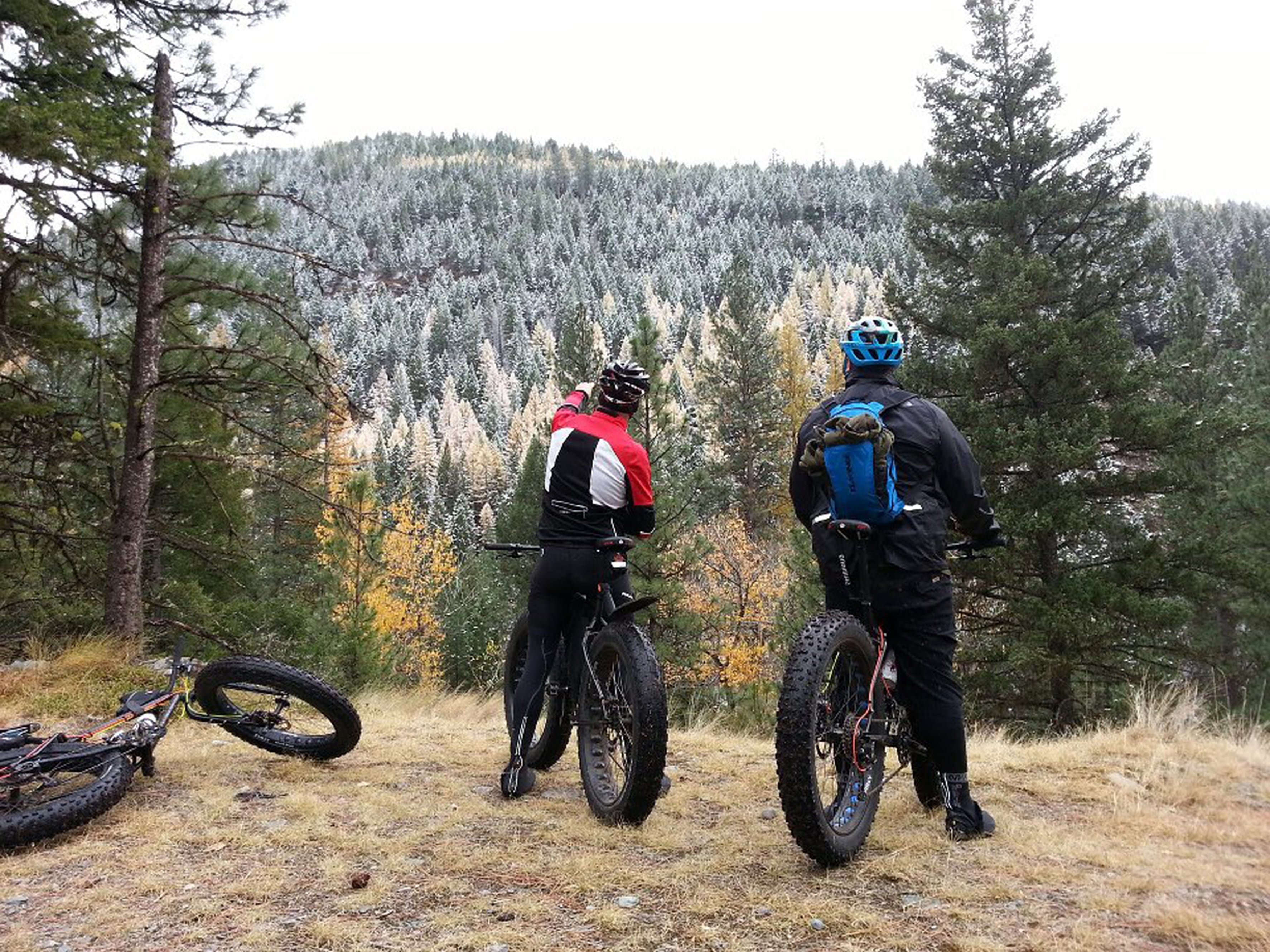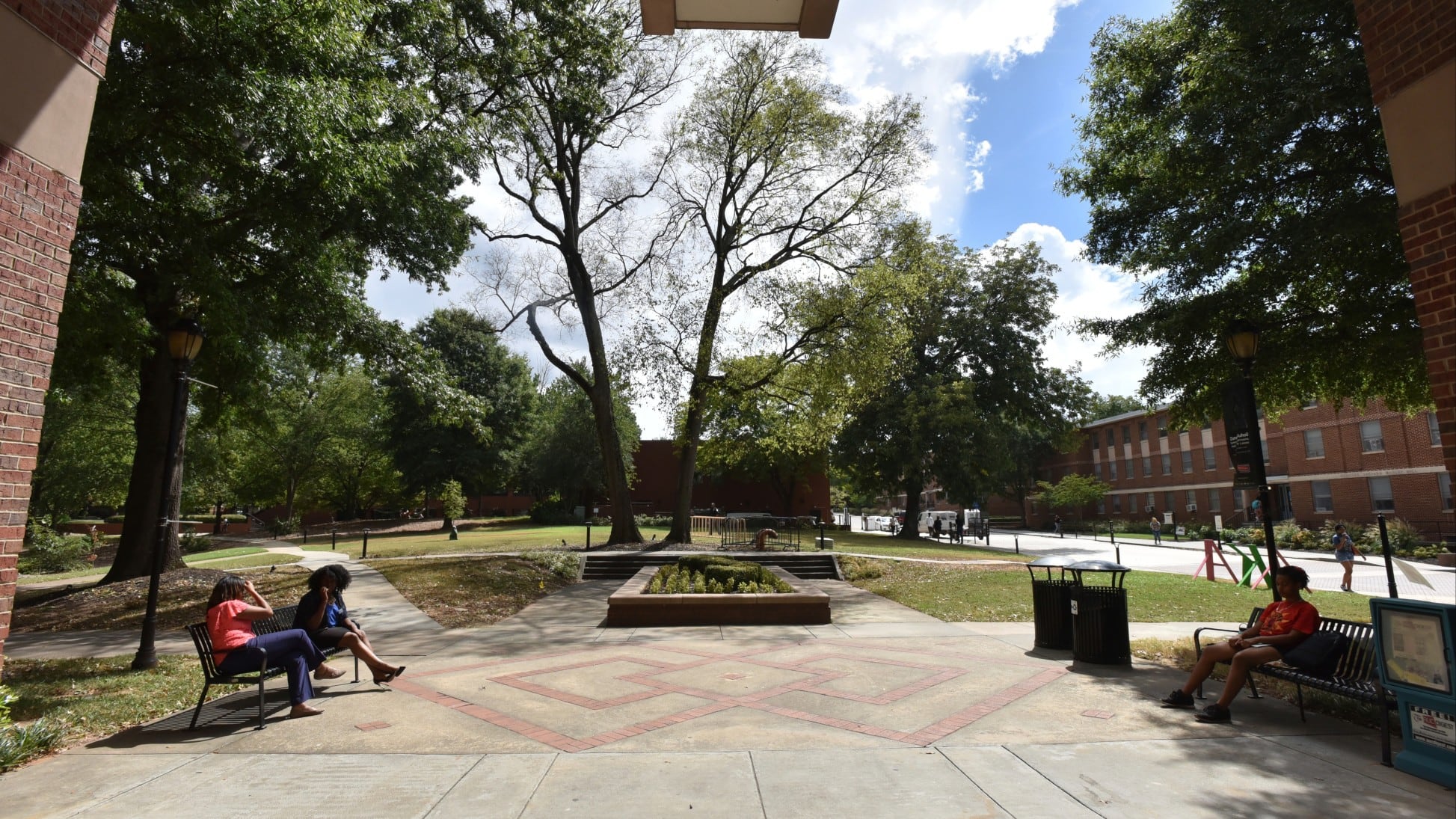But not anymore.
The newest two-wheeled trend in leg-powered action sports puts riders back in the action all year long — and over just about any terrain imaginable.
They're called fat bikes — and for good reason.
Indeed, most people do a double-take the first time they see one. At first glance they look like your typical mountain bike. But, whoa, check out those tires.
Not only are they big — with most tires bulking out a full four to five inches from the rims — but they're also super wide, requiring double-wide forks to accommodate their hulking girth.
If mountain bikes are the basic four-wheel-drives of cycling, fat bikes are the Humvees.

Fat bike riders enjoying the view at the Rattlesnake Recreation Area north of Missoula, Mont. Fat bikes are the true all-terrain vehicle of the mountain biking world, going where few bikes dare to tread.
Photo Credit: Travis Switzer
Just ask Travis Switzer, a spokesman and trail-mapper for the nonprofit Adventure Cycling Association based in Missoula, Montana.
"I love them. They can go anywhere," says Switzer, who's also a senior airman in the Montana Air National Guard's 219th Red Horse Squadron.
"For the cyclist who wants to ride all year, it actually makes these winter months something to look forward to — and not just for skiing or some other sport. As long as you dress warm enough, the fun never stops."
He should know. Switzer has been riding fat bikes for three years now.
"I was immediately hooked," he says. He bought his first fat bike after a co-worker at a cycling shop he worked at introduced him to the sport.
"For us here in Montana, it's the only way you can ride a bike year-round. And when you have a lot of cross-country skiing trails and bike-path infrastructure that gets covered in snow, that gives you a lot to play with," he says.
His first fat bike cost about $2,000, and, weighing in at nearly 40 pounds, it was as heavy as it was expensive.
"The really exciting thing now, though, is that as companies have started experimenting with how they build them, they're getting a lot lighter and a lot less expensive. You can get into them now starting at around $500, and new carbon-fiber frames are bringing the weights down below 30 pounds."
Iditabikers and sand crawlers
Fat bikes got off to a rocky — and frosty — start more than 25 years ago in Alaska, when hard-core riders and DIY bike builders first tried to harness the power of bigger tires to race across the background tundra on the Iditarod dog sled trails.
Around the same time, off-road riders from New Mexico to California were experimenting with their own early fat bikes for sand dune hot-dogging and beach-bombing.
In more recent years, fat bikes have been moving slowly into the mainstream, especially as riders have found fat bikes useful for more than just playing in the snow and sand.
"I think they're going to become a lot more ubiquitous as people get used to seeing them and what they can do," Switzer says.
"For example, we take them when we go fishing because you can ride along the weird little trails along the river banks that you normally wouldn't ever ride a bike. You can get down on the sandy river beds and just rip up and down them," Switzer says. "It's also easy to cross creeks where you'd normally have to dismount on skinny, two-inch mountain bike tires."
The all-weather capabilities of a fat bike also make it a great commuter ride.
"They open up a lot of commuting options. They're great in the rain. And if that rain starts to freeze over or it starts snowing, you can still get home."
Plus, there's a not a big learning curve for riding them.
"Basically, if you know how to ride a mountain bike, you'll be fine on a fat bike," Switzer says.
Rental shops are starting to offer them year-round, and for winter-sport options, a growing number of ski resorts are starting to open up cross-country skiing trails to them.
"In the right conditions, a fat bike can be the ultimate winter backcountry travel tool," reads the International Mountain Bicycling Association's primer on fat biking, opening "access to areas that are impassible during the warmer months."
"It's become a whole new winter recreation market," says Switzer. "Plus, they're a lot faster than cross-country skiing, but don't leave as much of a footprint because the tire is so wide, you're not rutting out the trail. It's definitely fun, too. You can cover a lot of ground."
Buying guide
If the idea of winter riding gives you the chills, think again.
"When you're pedaling, you work up quite a bit of body heat. So it's not hard to stay warm as long as you're moving. It gets real cold when you're coming downhill and the wind becomes a factor. So, I dress like I would to go skiing, with a bunch of layers," he says. "I've been out when it's been 10 degrees below zero, but you still stay surprisingly warm."
If you're ready to start shopping around for one, some styles will do a little better on snow, while others are more geared for sand and dirt.
"So, if you want to do a bunch of snow riding, a 100-mm rim and a 5-inch tire is going to give you the best flotation. You'll be able to ride through a lot of slush and other stuff that you wouldn't be able go through with even an 80-mm rim and a four-inch tire."
For those looking to do more dirt and sand riding look for four-inch tires and narrower rims.
Frame options range from heavier steel, lighter and rust-resistant aluminum alloys and the lightest, but most expensive, carbon-fiber models.
High-end bikes can cost more than $3,000, but the budget brands in the $500 range are great places to start, Switzer says.
"You're not going to do any competitive racing on a $500 fat bike, but you can still have some serious fun. And if you're going to college in a snowy town, it will totally get you to class every day," he says.
While sStandard — and still generally lighter — mountain bikes still have their place, he says, but "if I could only have one bike, it would be a fat bike. I'd try to eliminate the weight issue as much as possible, but yeah, it's the only bike I can really ride in a huge variety of circumstances and is really fun, and do that all year long."





